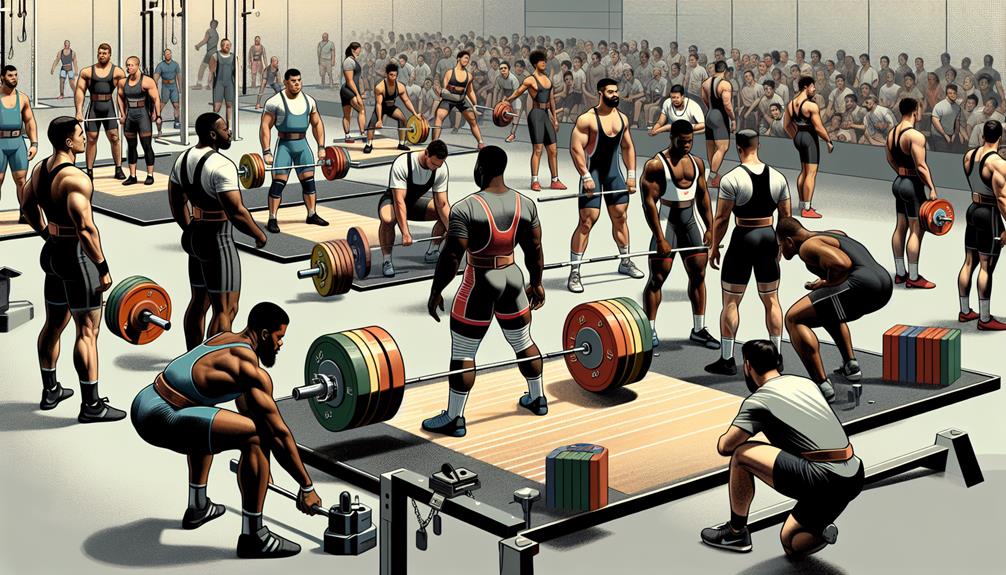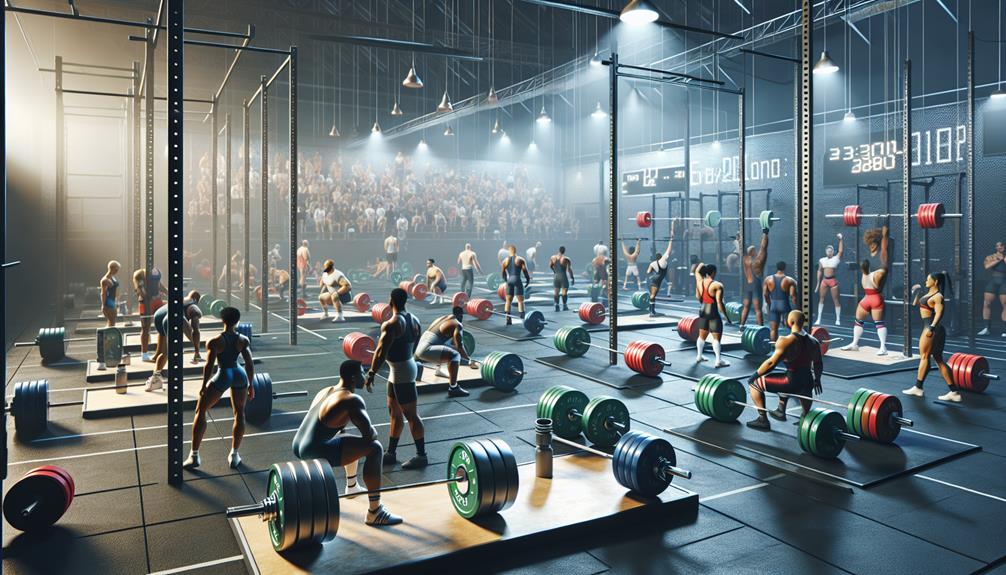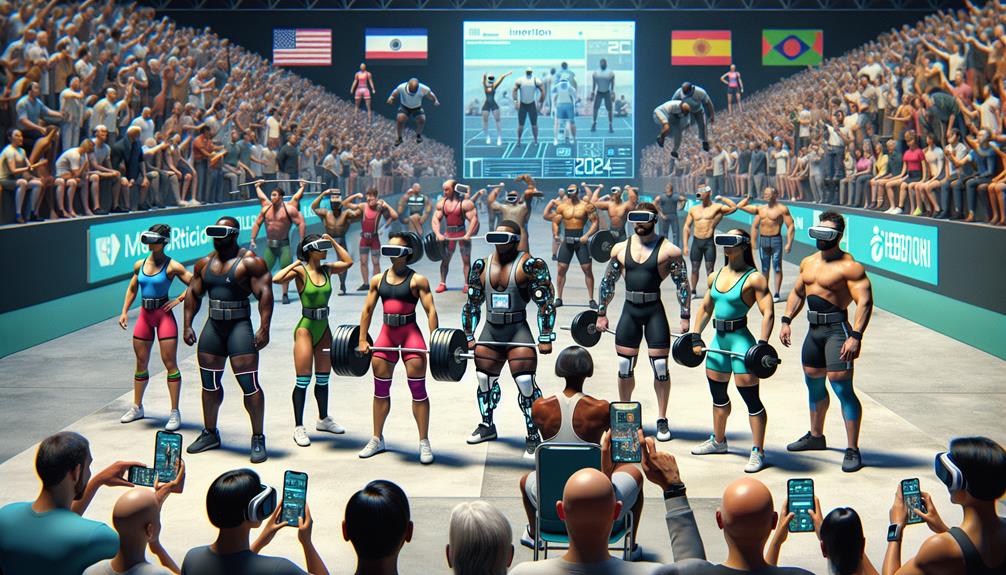Keen to discover the game-changing updates revolutionizing powerlifting competitions in 2024?
As we explore the landscape of powerlifting in 2024, the realm of competition is undergoing notable transformations. With a keen eye on fairness and safety, the latest updates have brought about a wave of changes that are shaping the future of the sport. From revamped scoring systems to cutting-edge technology integration, these enhancements are poised to elevate the powerlifting experience for athletes and enthusiasts alike. Join us as we uncover the intricacies of these updates and their potential impact on the powerlifting community.
Key Takeaways
- Streamlined weight class categories for enhanced competition dynamics and fairness.
- Enhanced Drug Testing Protocols to uphold sport integrity.
- Revised Scoring Criteria for accurate and fair judging.
- Introduction of team competitions and virtual events for innovative competition formats.
- Improved Safety Standards with stricter regulations for athlete well-being.
Updated Weight Class Categories
We’ve streamlined the weight class categories in powerlifting to enhance competition dynamics and fairness for all athletes. These weight class adjustments were made to ensure a more level playing field and to promote inclusivity within the sport. The new weight class categories are structured in a way that allows athletes to compete more effectively based on their body weight, thus mitigating any potential advantages or disadvantages due to weight differences.
Competition rules have been updated to accommodate these weight class adjustments seamlessly. Athletes will now compete in categories that align more closely with their body weight, allowing for fairer and more exciting competitions. The changes in weight class categories will also make it easier for athletes to track their progress and set realistic goals within their respective weight classes.
Furthermore, these adjustments aim to encourage more athletes to participate in powerlifting by providing a more welcoming and equitable competitive environment. By refining the weight class categories and competition rules, we’re fostering a community that values diversity and celebrates athletic achievements regardless of body size. These changes reflect our commitment to evolving with the sport and prioritizing the needs and experiences of all powerlifting athletes.
Enhanced Drug Testing Protocols

With the recent updates in weight class categories aimed at promoting fairness and inclusivity in powerlifting competitions, our focus now shifts to implementing enhanced drug testing protocols to uphold the integrity of the sport.
Enhanced monitoring and strict enforcement are essential components of our new approach to drug testing in powerlifting competitions.
To ensure fair play and maintain a level playing field, we’ve enhanced our drug testing protocols significantly. Athletes can expect increased frequency and randomness of testing both in and out of competition. This enhanced monitoring will help deter the use of performance-enhancing substances and ensure that all competitors adhere to the rules and regulations governing drug use in powerlifting.
Strict enforcement of our drug testing policies is non-negotiable. Any violations will be met with severe consequences, including disqualification and potential bans from future competitions. We’re committed to creating a clean and transparent environment where strength and skill are the true determinants of success.
Revised Scoring Criteria

Implementing revised scoring criteria will enhance the accuracy and fairness in evaluating powerlifting performances. Scoring adjustments are crucial in ensuring that powerlifting competitions are judged consistently and objectively. By fine-tuning the performance metrics used for scoring, athletes can be evaluated more fairly based on their actual strength and abilities. Let’s delve into the key changes in the scoring criteria for powerlifting competitions in 2024.
Scoring Adjustments and Performance Metrics
Here is a breakdown of the revised scoring criteria that will be implemented:
| Criteria | Description | Impact |
| Execution of Lifts | Emphasis on technical proficiency | Ensures fair judging |
| Strength Displayed | Quantifying the amount of weight lifted | Reflects athlete’s power |
| Consistency | Frequency of successful lifts | Highlights reliability |
These adjustments will provide a more comprehensive evaluation of each athlete’s performance. By focusing on both the technical execution of lifts and the strength displayed, the scoring criteria aim to reward well-rounded powerlifters who excel in all aspects of the sport. Moreover, consistency in successfully completing lifts will be a key factor in determining an athlete’s overall score, promoting reliability and repeatability in performances. These scoring changes will elevate the standard of powerlifting competitions, ensuring a more equitable and precise evaluation of athletes’ abilities.
New Competition Formats

To further enhance the dynamics of powerlifting competitions, the introduction of new competition formats will offer athletes and spectators fresh challenges and experiences in 2024. One exciting addition is the incorporation of team competitions, where powerlifters will have the opportunity to compete not only for personal bests but also as part of a team, fostering camaraderie and team spirit within the powerlifting community. This format adds a new layer of strategy as teams strategize on which athletes will compete in each category to maximize their overall team score.
Additionally, the rise of virtual events will revolutionize the way powerlifting competitions are conducted. Athletes will have the chance to compete from remote locations, breaking down geographical barriers and allowing a more inclusive participation. Virtual events will provide flexibility for athletes with busy schedules, enabling them to compete without the need for extensive travel.
Moreover, the inclusion of adaptive athletes and para powerlifting opportunities will further diversify the competition landscape, showcasing the incredible strength and determination of athletes with disabilities. By providing a platform for these athletes to excel, powerlifting competitions will become more inclusive and inspiring for all participants and spectators. The introduction of these new competition formats reflects the commitment to innovation and inclusivity within the powerlifting community in 2024.
Improved Safety Standards

Our focus on enhancing safety standards in powerlifting competitions involves meticulous evaluation and strategic adjustments to minimize risks and prioritize athlete well-being. Safety innovations are continuously being implemented to ensure the well-being of powerlifters. One key aspect is the introduction of stricter equipment regulations to prevent injuries. This includes mandatory checks on the quality and proper usage of gear such as belts, knee sleeves, and wrist wraps to guarantee they meet safety standards.
Injury prevention strategies are also at the forefront of our safety initiatives. Athletes now undergo comprehensive warm-up routines supervised by certified trainers to reduce the risk of muscular strains and tears during competitions. Additionally, a focus on proper technique and form is emphasized during training sessions to prevent common powerlifting injuries like herniated discs or muscle sprains.
Furthermore, advancements in competition layout contribute significantly to improving safety standards. Competitions are now organized in a way that allows for adequate rest periods between lifts, reducing the likelihood of fatigue-related injuries. Judges are also trained to recognize early signs of distress or improper lifting techniques, intervening promptly to prevent accidents.
Advanced Training Methods
As we explore the realm of advanced training methods in powerlifting, a focus on cutting-edge techniques and tailored programs emerges as a cornerstone for elevating athlete performance and pushing boundaries. To achieve peak performance in powerlifting, athletes need to delve into specialized strength conditioning programs that target specific muscle groups and movement patterns essential for the sport.
One key aspect of advanced training methods is periodization. By strategically cycling through different phases of training intensity and volume, athletes can optimize their strength gains and prevent plateaus. This periodization approach could include hypertrophy phases to build muscle mass, strength phases to improve maximal strength, and peaking phases to fine-tune performance leading up to competitions.
Incorporating advanced techniques like accommodating resistance training, where bands or chains are used to vary the resistance throughout the lift, can help develop explosive power and overcome sticking points in lifts. Additionally, advanced powerlifting programs often integrate accessory exercises targeting weak points identified through careful analysis of individual performance.
Advanced training methods also emphasize recovery strategies, such as implementing targeted mobility work, optimizing nutrition for performance gains, and ensuring adequate rest for proper muscle repair and growth. By embracing these cutting-edge techniques and tailored programs, powerlifters can unlock their full potential and achieve new levels of success in the sport.
Upgraded Equipment Regulations

With the evolving landscape of powerlifting, the implementation of upgraded equipment regulations has become paramount to ensure fair competition standards and athlete safety. Enhanced gear requirements and stricter enforcement have been put in place to maintain the integrity of the sport and provide a level playing field for all competitors.
- Standardized Gear Specifications: Powerlifting federations now mandate specific requirements for gear such as squat suits, bench shirts, and deadlift suits to ensure consistency across all competitions. This helps prevent any unfair advantages that may arise from variations in equipment quality or design.
- Regulated Gear Check Procedures: To enforce the enhanced gear requirements effectively, competitions now include rigorous gear check procedures. This involves thorough inspections of equipment to confirm compliance with the standardized specifications before athletes are permitted to compete. Any deviations can lead to disqualification or penalties.
- Transparent Enforcement Guidelines: Federations have established clear guidelines outlining the consequences of failing to meet the enhanced gear requirements. By transparently communicating the repercussions of non-compliance, athletes are encouraged to adhere to the regulations, promoting a culture of fairness and accountability within the powerlifting community.
Inclusive Gender Policies
Implementing inclusive gender policies in powerlifting competitions requires careful consideration of athlete diversity and equitable participation opportunities. Gender inclusion in powerlifting is vital for creating a welcoming and fair environment for all athletes. To ensure this, policy updates regarding gender categories, eligibility criteria, and competition rules are crucial.
In our commitment to gender equality, powerlifting organizations are revising their policies to accommodate athletes of all gender identities. This includes establishing clear guidelines for transgender and non-binary participants, ensuring they’ve the opportunity to compete in a category that aligns with their identity. These policy updates not only promote inclusivity but also uphold the principles of fairness and respect within the sport.
Furthermore, adjustments in competition rules are being made to guarantee that all athletes, regardless of gender, have equal opportunities to excel in powerlifting. This may involve reevaluating weight classes, performance standards, and scoring systems to accommodate different physiological characteristics among athletes. By implementing these changes, powerlifting competitions can become more inclusive and reflective of the diverse community of athletes they serve.
Innovative Technology Integration

Exploring the integration of cutting-edge technology in powerlifting competitions enhances performance monitoring and analysis for athletes. This advancement allows for more accurate tracking of progress and helps in identifying areas for improvement.
Here are three ways in which innovative technology is transforming the landscape of powerlifting:
- Virtual competitions: Virtual competitions are becoming increasingly popular, allowing athletes to compete from remote locations. This not only expands the reach of powerlifting events but also provides athletes with more opportunities to participate without the constraints of travel.
- Wearable tech: The integration of wearable technology such as smartwatches and fitness trackers revolutionizes how athletes track their performance. These devices can monitor metrics like heart rate, calories burned, and even provide real-time feedback on lifting form, aiding in injury prevention and overall performance enhancement.
- Data analytics and performance tracking: Data analytics play a crucial role in powerlifting by providing insights into an athlete’s performance trends over time. By analyzing this data, coaches and athletes can make informed decisions on training strategies, nutrition plans, and recovery protocols, ultimately optimizing performance on the platform.
Global Powerlifting Event Expansion

The expansion of global powerlifting events is reshaping the competitive landscape for athletes worldwide. Venue selection plays a crucial role in this expansion, with organizers strategically choosing locations that cater to a diverse range of participants. By diversifying venues, powerlifting events can attract a broader pool of competitors, enhancing the overall competitiveness and inclusivity of the sport.
Event promotion is another key aspect of global powerlifting event expansion. Through targeted marketing campaigns and social media outreach, organizers can generate buzz and attract both seasoned athletes and newcomers to the sport. Increased media coverage further amplifies the reach of these events, showcasing the dedication and strength of powerlifters on a global scale.
Sponsorship opportunities are abundant in the realm of global powerlifting events. Companies eager to align themselves with the values of strength, determination, and perseverance often seek to partner with these competitions, providing financial support and resources that elevate the overall experience for athletes and spectators alike. These partnerships not only benefit the events themselves but also contribute to the growth and development of powerlifting as a sport.
Frequently Asked Questions
How Will the New Weight Class Categories Impact Current Records?
When weight class changes occur in powerlifting, they directly impact records by redistributing achievements across new categories. These adjustments can lead to record-breaking performances as athletes strive to excel in the revised weight classes.
Are There Any Notable Changes in the Drug Testing Procedures?
Drug testing protocols have evolved to ensure fair play and athlete eligibility. Stringent measures, including random testing and advanced detection methods, uphold the integrity of the sport. Athletes must comply with these regulations to compete.
Will the Revised Scoring Criteria Favor Certain Lifting Styles?
Favored styles in powerlifting can significantly impact scoring. Techniques like sumo or conventional deadlifts, wide or close grip bench presses, and high or low bar squats may be favored based on judges’ criteria.
What Are the Specifics of the New Competition Formats Introduced?
New rules have been implemented in powerlifting competitions. The competition structure now includes revised scoring adjustments and updated equipment regulations. These changes aim to enhance fairness, transparency, and the overall competitiveness of the sport.
How Do the Improved Safety Standards Enhance Athlete Protection?
Improved equipment and training techniques significantly enhance athlete protection. Properly calibrated gear reduces injury risks, while advanced training methods focus on injury prevention. These advancements ensure a safer environment for athletes, prioritizing their well-being and performance.
Conclusion
As we close the chapter on the 10 Best Powerlifting Updates and Competition Changes for 2024, we see a new dawn rising in the world of powerlifting. Like a weight being lifted off our shoulders, these advancements symbolize progress, strength, and evolution in the sport.
Let’s continue to push our limits, break barriers, and strive for excellence as we embrace these changes and propel powerlifting to new heights. Together, we lift.













